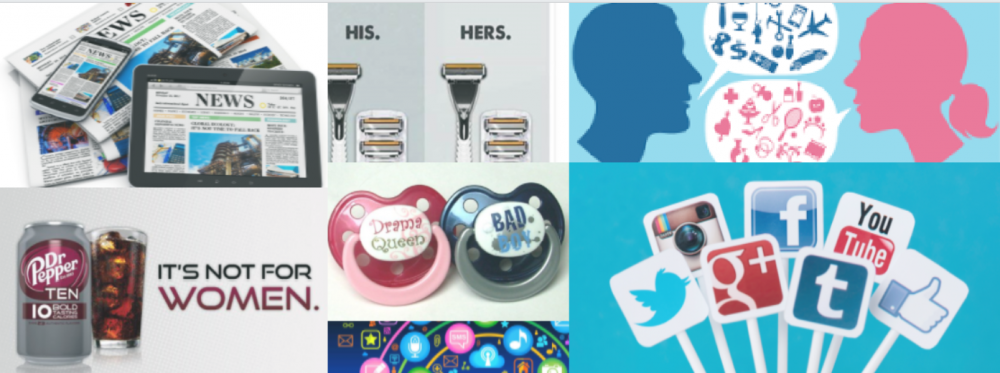People have likely heard the idiom “you are what you eat”. Could the idiom apply to media as “you are what you consume”? Signs point to yes. Media today includes everything public – TV, movies, websites, social sites, radio, commercials. One salient influence of the media is its influence on people’s perception on the meaning of being a man or woman. Femininity and masculinity are portrayed as hyperboles of the norm through visual media – auditory media too, but most obviously in the visual sources. Although people often think they are not paying attending to things like ads, it is the cumulative effect of seeing the same motifs that result in influence. The influences of media, while sometimes positive, are often negative as one group is lifted at the expense of another.
Historically, to be feminine is subordinate to being masculine; this leads to trends such as it being socially acceptable for girls to wear pants and shorts, but socially deviant for boys to wear dresses and skirts. A woman objectified in an add is viewed without question, but a man objectified raises uproar. Commercials often u se sex to sell products – the tactic makes for a memorable ad, which means customers are more likely to purchase the company’s product due to familiarity. The problem, however, lies in the fact women are usually the ones being negatively sexualized for the product. The female body is often nude and dismembered; when the head is included the face will be obscured.
se sex to sell products – the tactic makes for a memorable ad, which means customers are more likely to purchase the company’s product due to familiarity. The problem, however, lies in the fact women are usually the ones being negatively sexualized for the product. The female body is often nude and dismembered; when the head is included the face will be obscured. 

The result? People are conditioned to view women as a sum of their individual parts instead of a whole person – with emphasis on the breasts and butt since they are associated with sexual contexts.
While media turns women into isolated parts, men hear they should be callous, immune to all emotions, yet they should express aggression to assert power. Media tells men compassion and sadness equal weakness, and expressing them makes them less manly. Because compassion and showing sadness are deemed feminine traits, telling men they are bad essentially relays the message femininity and being feminine – that is being a woman, is bad. Idioms like “don’t be such a girl”, “man up”, and “you throw like a girl” reinforce the notion girls are weak and subordinate to boys. Always has a commercial focused on the “…like a girl” idiom. Boys and girls of various adolescent ages are asked to demonstrate “throw like a girl” and “run like a girl”. The older participants displayed stereotypical running and throwing involving poor form, weakness, and dramatization of pettiness, like the “oh my hair” exclamation. The youngest participants displayed normal running motions when asked the question. This social experiment provides evidence the degrading of girls and feminine qualities is a socially learned association. Always “like a girl” commercial
The gender divide is also pervasive in marketing, like color schemes associated exclusively for girls and boys. Companies make products, identical in purpose and efficiency, but the products are marketed separately for men and women. This is common in hygiene products: shaving razors, shampoo and conditioner, lotion, deodorant – to name a few out of countless. From a marketing standpoint, gender marketing is a money-efficient tactic. Because parents feel they cannot share products between their kids of different genders, more products are likely to be bought. Also, since children grow up conditioned to like things correlating to their gender, they are more likely to want different versions of the same product. The rift goes beyond preference when one realizes products marketed for women are often more expensive than their male-targeted counterpart. Again, hygiene products are a prime example. Google “Gillette razors: a Mach3 pack of 20 count refills with one handle costs $36.99. Google “Gillette Venus razors” (the company’s women’s razor): a pack of Spa Razor with 12 – yes 12, not 20 – refills and one handle costs $43.11. Same company. Same product. Same quality. Different price.
On top of over-priced products, women at e expected to shave more then men, both more of their body and more often – “no one wants hairy legs in the summer”, as is common to hear. Gender marketing is useful for sellers, being a detriment to women costumers crosses a line of ethics, albeit a line few people realize is broken.
The media belongs to the masses, supply and demand as people say, but where does the boundary of demand end and manipulation begin? The media has a history of hyper feminizing women while hyper masculinizing men. Women are taught to be submissive, that they need a man to take care of them. Men are taught a “real man” shows no emotion, and the ideal man has no emotion, therefore he has nothing to hide. The marketing industry perpetuates the binary gender divide as people grow up believing certain colors, types of clothes, and products are strictly for one gender or the other. Whether people are away of it or not, they are influenced by media they consume. We are what we eat.
Works Referenced
Always “…like a girl” commercial
Miss Representation
Still Killing Us Softly 4
Tough Guise 2: Violence, Manhood & American Culture


